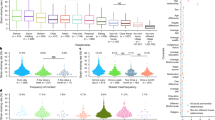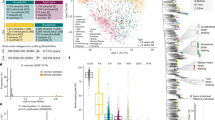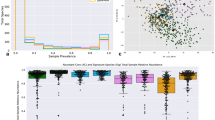Abstract
The human microbiome, described as an accessory organ because of the crucial functions it provides, is composed of species that are uniquely found in humans1,2. Yet, surprisingly little is known about the impact of routine interpersonal contacts in shaping microbiome composition. In a relatively ‘closed’ cohort of 287 people from the Fiji Islands, where common barriers to bacterial transmission are absent, we examine putative bacterial transmission in individuals’ gut and oral microbiomes using strain-level data from both core single-nucleotide polymorphisms and flexible genomic regions. We find a weak signal of transmission, defined by the inferred sharing of genotypes, across many organisms that, in aggregate, reveals strong transmission patterns, most notably within households and between spouses. We were unable to determine the directionality of transmission nor whether it was direct. We further find that women harbour strains more closely related to those harboured by their familial and social contacts than men, and that transmission patterns of oral-associated and gut-associated microbiota need not be the same. Using strain-level data alone, we are able to confidently predict a subset of spouses, highlighting the role of shared susceptibilities, behaviours or social interactions that distinguish specific links in the social network.
This is a preview of subscription content, access via your institution
Access options
Access Nature and 54 other Nature Portfolio journals
Get Nature+, our best-value online-access subscription
$32.99 / 30 days
cancel any time
Subscribe to this journal
Receive 12 digital issues and online access to articles
$119.00 per year
only $9.92 per issue
Buy this article
- Purchase on SpringerLink
- Instant access to full article PDF
Prices may be subject to local taxes which are calculated during checkout




Similar content being viewed by others
Code availability
The code for the analyses in this paper start with an alignment table in the form of a Python dictionary containing individual core genes as its highest-level keys, where for each core gene there is a M × N × 4 numpy array, for M subjects, N loci and four different alleles (A, G, C and T). The code for filtering these alignment tables into SNP tables and Manhattan distance calculations, and scripts for identifying non-shared mobile genetic elements from 1-kb regions are posted on GitHub at https://github.com/thomasgurry/fijiComp_transmission.
Data availability
Additional information on the samples can be obtained from www.fijicomp.org. All samples may be downloaded from the NCBI Short Read Archive under Bioproject PRJNA217052. Note that the name for sample SRS475548 in the Short Read Archive was incorrectly entered; it should be the oral microbiome sample from M2.33, not W2.33. All accession numbers are listed in Supplementary Table 1. Sample collection was voluntary; thus, not all of the individuals have oral and gut microbiome samples associated with the surveys.
References
Moeller, A. H. et al. Rapid changes in the gut microbiome during human evolution. Proc. Natl Acad. Sci. USA 111, 16431–16435 (2014).
Davenport, E. R. et al. The human microbiome in evolution. BMC Biol. 15, 127 (2017).
Thompson, L. R. et al. A communal catalogue reveals Earth’s multiscale microbial diversity. Nature 551, 457–463 (2017).
Nayfach, S., Rodriguez-Mueller, B., Garud, N. & Pollard, K. S. An integrated metagenomics pipeline for strain profiling reveals novel patterns of bacterial transmission and biogeography. Genome Res. 26, 1612–1625 (2016).
Ferretti, P. et al. Mother-to-infant microbial transmission from different body sites shapes the developing infant gut microbiome. Cell Host Microbe 24, 133–145 (2018).
Yassour, M. et al. Strain-level analysis of mother-to-child bacterial transmission during the first few months of life. Cell Host Microbe 24, 146–154 (2018).
Rothschild, D. et al. Environment dominates over host genetics in shaping human gut microbiota. Nature 555, 210–215 (2018).
Goodrich, J. K. et al. Human genetics shape the gut microbiome. Cell 159, 789–799 (2014).
Yatsunenko, T. et al. Human gut microbiome viewed across age and geography. Nature 486, 222–227 (2012).
Xie, H. et al. Shotgun metagenomics of 250 adult twins reveals genetic and environmental impacts on the gut microbiome. Cell Syst. 3, 572–584 (2016).
David, L. A. et al. Host lifestyle affects human microbiota on daily timescales. Genome Biol. 15, R89 (2014).
Faith, J. J. et al. The long-term stability of the human gut microbiota. Science 341, 1237439 (2013).
Brito, I. L. et al. Mobile genes in the human microbiome are structured from global to individual scales. Nature 535, 435–439 (2016).
Cleary, B. et al. Detection of low-abundance bacterial strains in metagenomic datasets by eigengenome partitioning. Nat. Biotechnol. 33, 1053–1060 (2015).
Mosites, E. et al. Microbiome sharing between children, livestock and household surfaces in western Kenya. PLoS ONE 12, e0171017 (2017).
Li, S. S. et al. Durable coexistence of donor and recipient strains after fecal microbiota transplantation. Science 352, 586–589 (2016).
Franzosa, E. A. et al. Identifying personal microbiomes using metagenomic codes. Proc. Natl Acad. Sci. USA 112, E2930–E2938 (2015).
Korpela, K. et al. Selective maternal seeding and environment shape the human gut microbiome. Genome Res. 28, 561–568 (2018).
Smillie, C. S. et al. Strain tracking reveals the determinants of bacterial engraftment in the human gut following fecal microbiota transplantation. Cell Host Microbe 23, 229–240 (2018).
Caugant, D. A., Levin, B. R. & Selander, R. K. Distribution of multilocus genotypes of Escherichia coli within and between host families. J. Hyg. (Lond.) 92, 377–384 (1984).
Preus, H. R., Zambon, J. J., Dunford, R. G. & Genco, R. J. The distribution and transmission of Actinobacillus actinomycetemcomitans in families with established adult periodontitis. J. Periodontol. 65, 2–7 (1994).
Van Winkelhoff, A. J. & Boutaga, K. Transmission of periodontal bacteria and models of infection. J. Clin. Periodontol. 32, 16–27 (2005).
Lloyd-Smith, J. O., Schreiber, S. J., Kopp, P. E. & Getz, W. M. Superspreading and the effect of individual variation on disease emergence. Nature 438, 355–359 (2005).
Taking Sex and Gender into Account in Emerging Infectious Disease Programmes: an Analytical Framework (WHO, 2011).
Carr, E. J. et al. The cellular composition of the human immune system is shaped by age and cohabitation. Nat. Immunol. 17, 461–468 (2016).
Lax, S. et al. Longitudinal analysis of microbial interaction between humans and the indoor environment. Science 345, 1048–1052 (2014).
Sivan, A. et al. Commensal Bifidobacterium promotes antitumor immunity and facilitates anti-PD-L1 efficacy. Science 350, 1084–1089 (2015).
Rosshart, S. P. et al. Wild mouse gut microbiota promotes host fitness and improves disease resistance. Cell 171, 1015–1028 (2017).
Moeller, A. H. et al. Social behavior shapes the chimpanzee pan-microbiome. Sci. Adv. 2, e1500997 (2016).
Zerbino, D. R. & Birney, E. Velvet: algorithms for de novo short read assembly using de Bruijn graphs. Genome Res. 18, 821–829 (2008).
Wu, M. & Scott, A. J. Phylogenomic analysis of bacterial and archaeal sequences with AMPHORA2. Bioinformatics 28, 1033–1034 (2012).
Li, H. Aligning sequence reads, clone sequences and assembly contigs with BWA-MEM. Preprint at https://arxiv.org/abs/1303.3997 (2013).
Bolger, A. M., Lohse, M. & Usadel, B. Trimmomatic: a flexible trimmer for Illumina sequence data. Bioinformatics 30, 2114–2120 (2014).
Truong, D. T. et al. MetaPhlAn2 for enhanced metagenomic taxonomic profiling. Nat. Methods 12, 902–903 (2015).
Fu, L., Niu, B., Zhu, Z., Wu, S. & Li, W. CD-HIT: accelerated for clustering the next-generation sequencing data. Bioinformatics 28, 3150–3152 (2012).
Buchfink, B., Xie, C. & Huson, D. H. Fast and sensitive protein alignment using DIAMOND. Nat. Methods 12, 59–60 (2015).
Acknowledgements
This work was supported by funding from the Center for Microbiome Informatics and Therapeutics at the Massachusetts Institute for Technology (MIT). This work was supported by grants from the National Human Genome Research Institute (U54HG003067) to the Broad Institute, the Center for Environmental Health Sciences at MIT, the Center for Microbiome Informatics and Therapeutics at MIT, and the Fijian Ministry of Health. I.L.B. is a Sloan Foundation Research Fellow, a Packard Fellowship in Science and Engineering, and a Pew Foundation Biomedical Scholar.
Author information
Authors and Affiliations
Contributions
This study was conceived by I.L.B. and E.J.A. The study was designed by I.L.B., A.P.J., S.P.J. and E.J.A. Raw data were collected by I.L.B. and W.N. Metagenomic assemblies and metrics were developed and assessed by I.L.B., T.G., S.Z., K.H., S.K.Y., T.P.S., D.G. and E.J.A. Final analyses were performed by I.L.B. and T.G. The paper was written by I.L.B., T.G. and E.J.A.
Corresponding authors
Ethics declarations
Competing interests
The authors declare no competing interests.
Additional information
Publisher’s note: Springer Nature remains neutral with regard to jurisdictional claims in published maps and institutional affiliations.
Supplementary information
Supplementary Information
Supplementary Figures 1–27 and Supplementary Table Legends.
Supplementary Tables 1–5
Supplementary Table 1: information on the FijiCOMP study participants; Supplementary Table 2: social network relationships; Supplementary Tables 3 and 4: information about the gut and saliva microbiome metagenomic assemblies, respectively; Supplementary Table 5: core genes used for SNP analyses.
Rights and permissions
About this article
Cite this article
Brito, I.L., Gurry, T., Zhao, S. et al. Transmission of human-associated microbiota along family and social networks. Nat Microbiol 4, 964–971 (2019). https://doi.org/10.1038/s41564-019-0409-6
Received:
Accepted:
Published:
Issue date:
DOI: https://doi.org/10.1038/s41564-019-0409-6
This article is cited by
-
Transmission of the human respiratory microbiome and antibiotic resistance genes in healthy populations
Microbiome (2025)
-
Integrating metagenomics and cultivation unveils oral phage diversity and potential impact on hosts
npj Biofilms and Microbiomes (2025)
-
A prebiotic dietary pilot intervention restores faecal metabolites and may be neuroprotective in Parkinson’s Disease
npj Parkinson's Disease (2025)
-
A new strain of thought in gut metagenomics
Nature Reviews Microbiology (2025)
-
Gut microbiome strain-sharing within isolated village social networks
Nature (2025)



